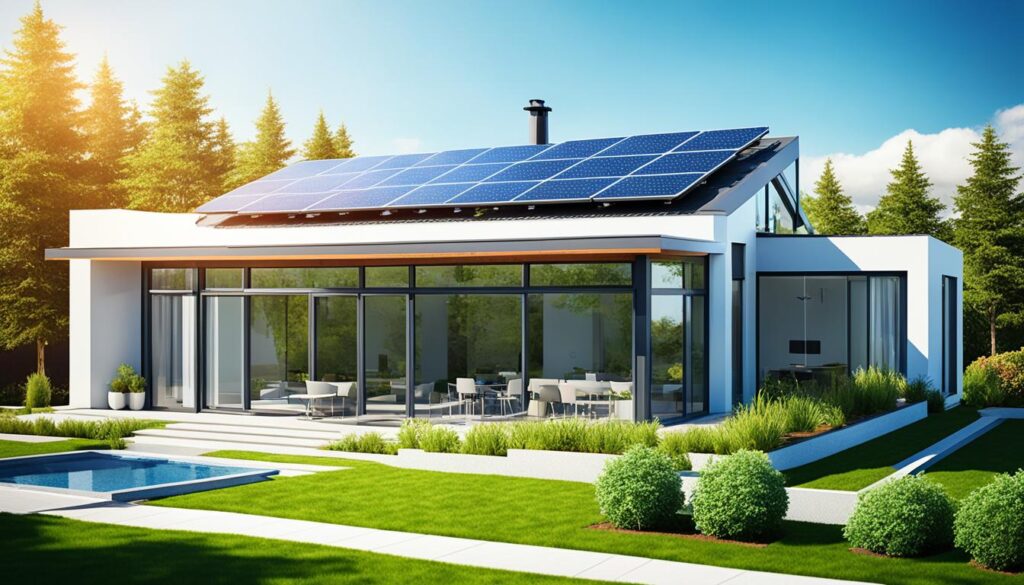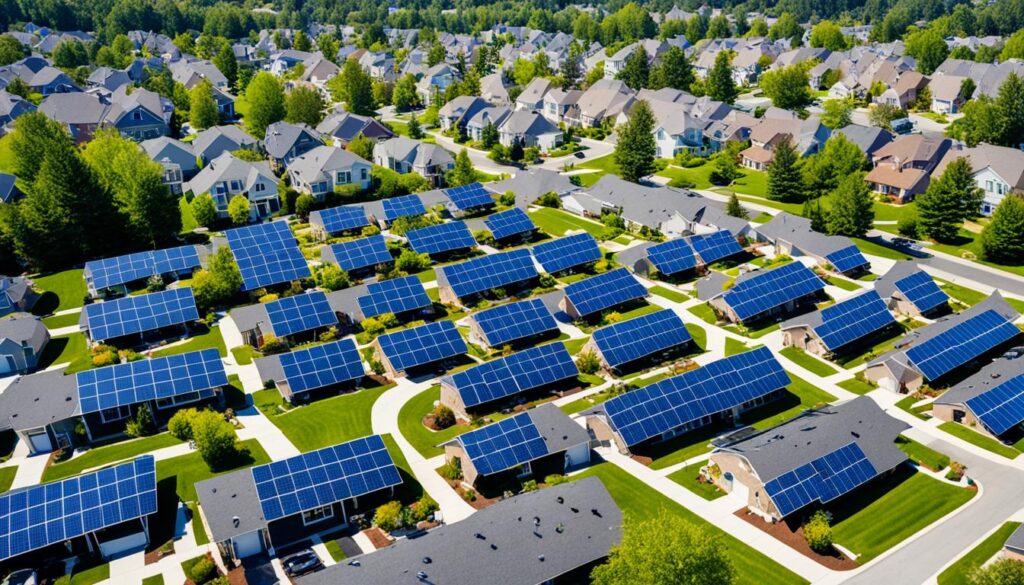The residential rooftop solar industry is booming. It gives homeowners a cost-effective way to use solar energy. Solar energy systems are installed on the roofs. They turn sunlight into clean, renewable electricity.
There are two main types of residential rooftop solar systems. One has batteries for storing extra energy. The other, our focus here, is connected to the grid. This system turns sunlight into electricity. Then it sends it to the electrical grid. It powers the building when there’s enough sunlight. If not, the building gets power from the grid.
Key Takeaways
- Residential rooftop solar systems offer a convenient and cost-effective way to harness the power of the sun.
- Grid-connected rooftop solar systems convert sunlight into electricity and feed it into the electrical grid.
- Excess solar power generated during the day can be fed back into the grid, while the grid can provide power when the solar energy system is insufficient.
- Home solar installation provides a reliable and sustainable source of renewable energy for residential buildings.
- Rooftop solar systems contribute to the overall growth of renewable energy sources in India.
Understanding Residential Rooftop Solar Systems
More and more people are turning to renewable energy sources. For homeowners, installing solar panels on their roofs is becoming popular. This lets them use the sun’s power to create solar energy.
What is a Solar Rooftop System?
A solar rooftop system turns sunlight into electricity. It uses special panels on a building’s roof. These panels catch the sun’s energy and turn it into electricity. This electricity is made ready for use through a special unit. It can power the building or go into the community’s electrical grid.
Grid Connected Solar Rooftop System: How Does It Work?
A grid-connected solar rooftop system links the solar panels to the local electricity grid. Homeowners can then use the solar power they create. If they make extra, it goes back into the grid. This type of system works smoothly with the area’s power supply.
Solar Design and Placement
How well a residential rooftop solar system works depends on how it’s set up. Things like the roof’s direction, the angle of the panels, and roof space are key. They decide how much energy the system will produce. Thinking through these details when setting up your system is important. It makes sure you get the most out of your investment and any benefits.

Residential Rooftop Solar: Benefits and Considerations
Grid-connected rooftop solar systems work in a special way. Homeowners can sell extra electricity they make back to the grid. This helps cut down their power bills. Essentially, they use less energy from the usual power supply.
Solar Energy Metering
Through net metering, the power a rooftop solar system makes goes back into the grid. This makes the homeowner’s electricity bill go down. Any additional power they produce is turned into credits for later use. This strategy makes getting a grid-connected rooftop solar system very attractive. Homeowners can make some money back this way.
Rooftop Solar Savings
In India, the cost of grid-connected rooftop solar systems is around Rs. 50 per watt. This is about Rs. 5.0 crore for a full MWp system. The government helps Out with solar rebates, solar incentives, and solar tax credits to lower costs. The Ministry of New and Renewable Energy (MNRE) also gives financial help. For systems over 3 kW, they provide up to Rs. 78,000 in support. All this makes solar systems more within reach for people.
Safety Considerations and Maintenance
If the grid goes down, solar panels have to stop working right away. This is to keep repair workers safe. The idea is to prevent electricity from going out when technicians are fixing things. They call this ‘Islanding Protection.’
State Policies and Regulations
In India, 13 states/UTs have specific policies for grid-connected rooftop solar. Twenty more have made rules about net-metering/gross metering. These steps are vital in making more people go solar. Homeowners get solid support to use the sun’s energy and help the country meet its green energy goals.
Conclusion
Grid-connected Rooftop Solar Systems offer lots of benefits. They’re a great choice for those looking to use renewable energy. These systems cut down on the electricity lost during transmission. This makes it better for the environment and saves money.
Rooftop solar is becoming more popular, and it’s important to answer any questions people might have. These systems also improve the local power grid and create jobs. This makes our energy system better for everyone.
Getting solar panels for your home means you’re using the sun’s power. This helps the earth by cutting down on harmful emissions. It also saves you money over time. Choosing solar energy is a step towards a cleaner, more sustainable planet.
FAQ
What is a Solar Rooftop System?
A Solar Rooftop System is where solar panels are placed on a building’s roof. They turn sunlight into electricity. This electricity goes into the power grid after being converted.
How does a Grid Connected Solar Rooftop System work?
These systems take sunlight and turn it into power. Then, this power is converted for use by the power grid. The size of the power can vary.
It can go into high voltage lines or lower voltage ones. This depends on how much power the system makes and where it is placed.
How important is the design and placement of a solar system?
Design and placement are key for a solar system to work well. Things like where the panels face, their angle, and if they are shaded matter a lot. They affect how much energy the system produces.
How is the energy accounting done in grid-connected rooftop solar systems?
Energy accounting is about how extra power is handled. System owners can get credits for power they put into the grid. These credits lower their power bills.
What is the average cost of a grid-connected rooftop solar system in India?
In India, the average cost for these systems is about Rs. 50 per watt. The Ministry of New and Renewable Energy can help with up to Rs. 78,000 for systems over 3 kW.
What is “Islanding Protection” in grid-connected rooftop solar systems?
‘Islanding Protection’ ensures solar power stops going into the grid during a blackout. This keeps those fixing the grid safe.
What is the current status of grid-connected rooftop solar policies and regulations in India?
Currently, 13 states in India have policies for grid-connected solar systems. They include rules for sharing extra power with the grid. Also, 20 have specific regulations for this.
What are the advantages of Grid-connected Rooftop Solar Systems?
These systems have many benefits. They make power right where it’s used. This saves on power lost during delivery. They also help power companies and can boost the local economy.

